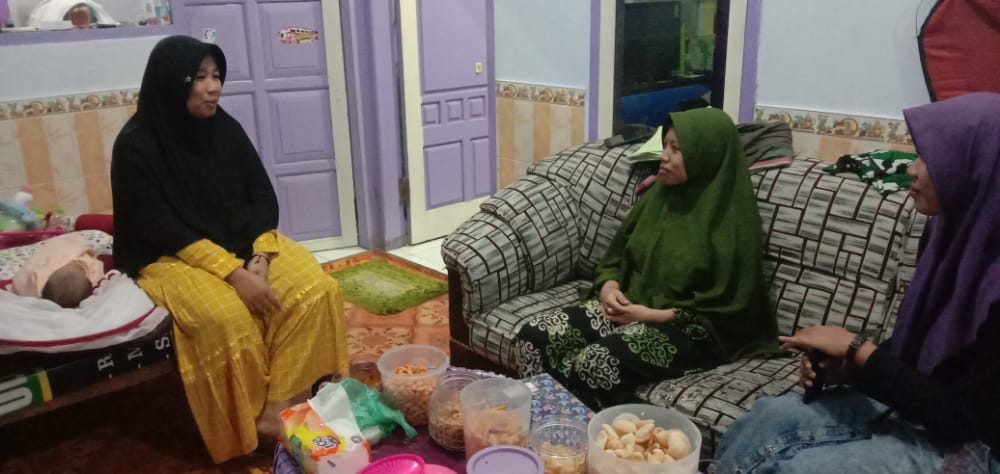Communication of Caregivers and Santri at Islamic Boarding Schools in a Gender Perspective
Komunikasi Pengasuh dan Santri di Pondok Pesantren dalam Perspektif Gender
DOI:
https://doi.org/10.21070/kanal.v9i1.628Keywords:
Communicaton, Caregivers, Santri, Islamic Boarding Schools, GenderAbstract
This strudy aim is to describe how the interaction between caregivers and students, both men and women, in Islamic boarding schools, as religious-based educational institutions. The location of the study is Bustanul Ulum Islamic boarding schools, Sawaran Kulon, Kedungjajang, Lumajang. This study uses qualitative method, through the phenomenological approach, which is introduced by Lanigan. Lanigan argued, the communication process has a correlation with the residence of communicator and the communicant. In the context of this study, the residence is the Islamic boarding school, while communicators and communicants are caregivers and students. Sources of research data obtained through observing and interviewing, and reading literature regarding the research topic. Observations carried out for ten days (March 15, 2020 until March 25, 2020). Interviews are conducted with caregivers and students. The results are, first; communication between caregivers and students in Bustanul Ulum Islamic boarding schools runs both verbally and non-verbally. In general, caregivers play a more communicator role, and santri become communicants. Second; communication carried out across gender. Only indeed, interactions and communication between Kiai and female santri are not as close and frequent as interactions and communication between Kiai and male santri. Likewise, interactions and communication between Nyai and male santri are not as close and frequent as Nyai and female santri interactions and communication. Because in the curriculum or rules that have been set, the who focuses of intensive teaching of male students, is the Kiai. While the one who focuses intensively in teaching female students, is Nyai.
References
Al-fakhuriziah, R. and Aesthetika, N. M. (2016). Etnografi Komunikasi Orang Tua - Anak di Kampung Inggris. KANAL: Jurnal Ilmu Komunikasi 4, 145–145. doi: 10.21070/kanal.v4i2.1448.
Almanshuri, M. F. (2015). Pola Komunikasi Antara Kiai Dan Santri Dalam Metode Pembelajaran Kitab Kuning (Jakarta: Fakultas Dakwah dan Komunikasi UIN Syarif Hidayatullah).
Arifuddin (21 Maret 2020). Santri Ponpes Busnatul Ulum Lumajang. Interview by Linda Nur Wahyuningsih.
Cangara, H. (2007). Pengantar Ilmu Komunikasi (Jakarta: PT. Raja Grafindo).
Chusniyah, S. (2017). Sosok Pemimpin Perempuan Di Pesantren: Studi Kasus Pesantren Putri Huffadzul Quran Al Ashor Di Kecamatan Gunungpati .
Dhavamony, M. (1995). Fenomenologi Agama (Yogyakarta: Kanisius).
Efendi, E. (2018). Gender Perspektif Etika Pesantren. An-nisa 11.
Effendy, O. U. (2006). Ilmu Komunikasi: Teori dan Praktek (Bandung: Penerbit Remaja Rosdakarya).
Fadhillah, M. (2018). Kepemimpinan Kiai Di Pondok Pesantren.
Handayani, T., Sugiarti, and Dharma, S. (2008). Konsep dan Teknik: penelitian gender (Malang: UMM Press).
Hariyanto, D. and Mariyanto, A. P. P. (2020). Motif Menonton Vlog” Keluarga Beti. Channel Youtube Arif Muhammad. Kanal: Jurnal Ilmu Komunikasi 8, 67–72.
Hartono, R. (2016). Pola Komunikasi di Pesantren: Studi tentang Model Komunikasi antara Kiai, Ustadz, dan Santri di Pondok Pesantren TMI Al-Amien Prenduan. Al Balagh: Jurnal Dakwah dan Komunikasi 1, 67–100.
Hasan, I. (2002). Pokok-Pokok Materi Metodologi Penelitian Dan Aplikasi (Jakarta: Ghalia Indonesia).
Ilmiyah, R. (21 Maret 2020). Interview by Linda Nur Wahyuningsih. Pengasuh Ponpes (Nyai muda) Bustanul Ulum Lumajang.
Karimah, U. (2018). `Pondok Pesantren dan Pendidikan: Relevansinya dalam Tujuan Pendidikan. MISYKAT: Jurnal Ilmu-ilmu Al-Quran, Hadist, Syari’ah dan Tarbiyah 3, 137–137. doi: 10.33511/misykat. v3n1.137.
Kurnianti, A. W. and Afrilia, A. M. (2020). Hubungan Intercultural Sensitivity Dengan Efektivitas Komunikasi Dalam Mencegah Bullying di SMA Taruna Nusantara Magelang. Kanal: Jurnal Ilmu Komunikasi 8, 42–49. doi: 10.21070/ kanal.v8i2.221.
Lanigan, R. L. (1977). The Phenomenology of Human Communication as a Rhetorical Ethic. In The Annual Meeting of the Central States Speech Association.
Madjid, N. (1997). Bilik-Bilik Pesantren: Sebuah Potret Perjalanan (Jakarta: Paramadina).
Malla, H. A. B. (2020). Implementation of Madrasah Head Leadership Communication In The Development of Religious Characters. Al-Mishbah: Jurnal Ilmu Dakwah dan Komunikasi 15, 147–147. doi: 10.24239/al-mishbah.vol15.iss2.158.
Marhumah (2018). Gender Dalam Lingkungan Sosial Pesantren.
Masfufah, N. M. (2010). Pengaruh Model Komunikasi Interpersonal Ketaatan Santri Pada Pengurus Di Pondok Pesantren Al-Ishlah Sendang Agung Paciran Lamongan.
Moleong, L. J. (2000). Metodologi Penelitian Kualitatif (Bandung: PT. Remaja Rosdakarya).
Mustair, A. (19 Maret 2020). Interview by Linda Nur Wahyuningsih. Pengasuh Ponpes (Kiai) Bustanul Ulum Lumajang.
Najmuddin, M. (2019). Aktivitas Komunikasi Dalam Ritual Keagamaan. Al-Mishbah: Jurnal Ilmu Dakwah dan Komunikasi 15, 263–282.
Nasvian, M. F., Prasetyo, B. D., and Wisadirana, D. (2013). Model Komunikasi Kyai dengan Santri (Studi Fenomenologi Pada Pondok Pesantren “Ribathi” Miftahul Ulum). Wacana Journal of Social and Humanity Studies 16, 197–206.
Ningrum, E. P. and Mursidi, A. (2018). Peranan dan Kedudukan Bu Nyai Dalam Memimpin Pondok Pesantren Di Kabupaten Banyuwangi. FKIP Universitas Pgri Banyuwangi. In Seminar Nasional, Pendidikan Budaya Dan Sejarah “Dibalik Revitalisasi Budaya”. 45–55.
Novianti, R. D., Sondakh, M., and Rembang, M. (2017). Komunikasi antarpribadi dalam menciptakan harmonisasi (suami dan istri) keluarga didesa Sagea Kabupaten Halmahera Tengah. Acta Diurna Komunikasi 6.
Putra, O. and Fitriani, D. R. (2019). Fenomena Internet Addiction Disorder Pada Gen Z. Kanal: Jurnal Ilmu Komunikasi 8, 22–26. doi: 10.21070/kanal.v8i1.104.
Rachman, R. F. (2015). Representasi Muslim Dalam Film- Film Produksi Hollywood, Analisis Dua Film Kathryn Bigelow: The Hurt Locker Dan Zero Dark Thirty.
Rachman, R. F. (2017). Menelaah Riuh Budaya Masyarakat di Dunia Maya. Jurnal Studi Komunikasi 1, 206–222.
Rachman, R. F. (2019). Implementasi Kebijakan Pusat Konseling Anak Dan Remaja Di Surabaya. Al-Tazkiah: Jurnal Bimbingan Dan Konseling Islam 8, 77–91.
Rachman, R. F. (2020). Kebijakan Pendidikan Anak Berkebu- tuhan Khusus Di Surabaya Dalam Perspektif Islam. Bidayatuna: Jurnal Pendidikan Guru Mandrasah Ibtidaiyah 3, 125–143.
Siswanto, A. and Febriana, P. (2018). Representasi Indonesia dalam Stand Up Comedy (Analisis Wacana Kritis Norman Fairclough dalam Pertunjukan Spesial Pandji Pragiwaksono “Mesakke Bangsaku”). KANAL: Jurnal Ilmu Komunikasi 5, 121–121. doi: 10.21070/kanal.v5i2.1508.
Soebakir, D. R., Pratama, B. I., and Hair, A. (2020). Pemetaan Meme Politik Pasca Pemilihan Umum Presiden Indonesia 2019. Kanal: Jurnal Ilmu Komunikasi 8, 58–66. doi: 10.21070/kanal.v8i2.220.
Sugiyono (2009). Metode Penelitian Kuantitatif Kualitatif Dan R&D (Bandung: Alfabeta).
Takdir, M. (2018). Modernisasi Kurikulum Pesantren (Yogyakarta: IRCiSoD).
Usman, H. (1996). Metode Penelitian Sosial (Jakarta: Bumi Aksara).






